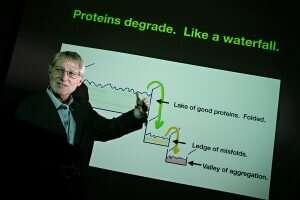Study reveals how collapse of protein processes is driver of aging and death

Cells undergo natural aging and death, processes that impact a multitude of cellular factors. A new Stony Brook University-led study, to be published in PNAS, provides a biophysical model that reveals how damage accumulates in the shapes of cellular proteins with age and is a trigger to death. The finding opens a door to a better understanding of the molecular origins of age-related neurodegenerative diseases, such as Alzheimer's and Parkinson's disease, which all entail protein damage.
Young cells are kept healthy by the positive processes of protein synthesis, degradation, and keeping proteins properly folded (called chaperoning). As cells age, negative processes increase, reducing proteins' ability to fold. One of these negative processes is oxidative damage, which the research team focuses on in the model. Once negative processes exceed positive ones, protein misfolding becomes rampant and cell death occurs.
Co-author Ken A. Dill, Ph.D., Distinguished Professor and Director of the Laufer Center for Physical & Quantitative Biology at Stony Brook, said that the research team developed a Proteome Collapse Model that explores a central question in biology: How does the folding health of proteomes (collection of all the cell's proteins) change with damage and age?
The team created a model of the worm (C. elegans), common to studies of cellular aging. They tested how proteostasis—the successful folding, aggregation and chaperoning of proteins—is affected by cumulative oxidative damage. Their model explains the remarkable fact that worms raised at 20 degrees Celsius have a lifespan of 20 days, but those worms raised at higher temperatures or in the presence of free radicals have a lifespan of only a few hours. They found this lifespan shortening to be consistent with the nature of the proteome collapse process. They also showed how it predicts the C. elegans survival curve (how many individuals are still alive at any given age).
"This modeling is unique by being mathematically detailed and describing a broad range of cellular processes across the cell's whole proteome," explains Dill. "Often, aging-related studies look at the effects of one or two proteins at a time, rather than seeking, more generally, the cellular aging mechanism itself."
The scientific approach also creates a foundation for further research into the molecular origins of age-related diseases based on protein misfolding processes.
More information: Mantu Santra et al. Proteostasis collapse is a driver of cell aging and death, Proceedings of the National Academy of Sciences (2019). DOI: 10.1073/pnas.1906592116
Journal information: Proceedings of the National Academy of Sciences
Provided by Stony Brook University




















